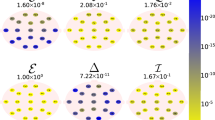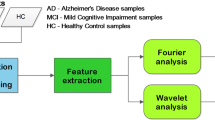Abstract
We have developed a novel approach to elucidate several discriminating EEG features of Alzheimer’s disease. The approach is based on the use of a variety of continuous wavelet transforms, pairwise statistical tests with multiple comparison correction, and several decision tree algorithms, in order to choose the most prominent EEG features from a single sensor. A pilot study was conducted to record EEG signals from Alzheimer’s disease (AD) patients and healthy age-matched control (CTL) subjects using a single dry electrode device during several eyes-closed (EC) and eyes-open (EO) resting conditions. We computed the power spectrum distribution properties and wavelet and sample entropy of the wavelet coefficients time series at scale ranges approximately corresponding to the major brain frequency bands. A predictive index was developed using the results from statistical tests and decision tree algorithms to identify the most reliable significant features of the AD patients when compared to healthy controls. The three most dominant features were identified as larger absolute mean power and larger standard deviation of the wavelet scales corresponding to 4–8 Hz (\(\theta\)) during EO and lower wavelet entropy of the wavelet scales corresponding to 8–12 Hz (\(\alpha\)) during EC, respectively. The fourth reliable set of distinguishing features of AD patients was lower relative power of the wavelet scales corresponding to 12–30 Hz (\(\beta\)) followed by lower skewness of the wavelet scales corresponding to 2–4 Hz (upper \(\delta\)), both during EO. In general, the results indicate slowing and lower complexity of EEG signal in AD patients using a very easy-to-use and convenient single dry electrode device.




Similar content being viewed by others
References
Abasolo D, Hornero R, Espino P, Alvarez D, Poza J (2006) Entropy analysis of the EEG background activity in Alzheimer’s disease patients. Physiol Meas 27(3):241–253
Adeli H, Zhou Z, Dadmehr N (2003) Analysis of EEG records in an epileptic patient using wavelet transform. J Neurosci Methods 123(1):69–87
Akin M (2002) Comparison of wavelet transform and FFT methods in the analysis of EEG signals. J Med Syst 26(3):241–247
Avanzo C, Tarantino V, Bisiacchi P, Sparacino G (2009) A wavelet methodology for EEG time-frequency analysis in a time discrimination task. Int J Bioelectromagn 11(4):185–188
Bassani T, Nievola JC (2008) Pattern recognition for brain-computer interface on disabled subjects using a wavelet transformation. In: IEEE Symposium on Computational Intelligence in Bioinformatics and Computational Biology. Sun Valley, USA, pp 180–186
Bennys K, Rondouin G, Vergnes C, Touchon J (2001) Diagnostic value of quantitative EEG in Alzheimer’s disease. Clin Neurophysiol 31(3):153–160
Bostanov V (2004) BCI competition 2003-data sets Ib and IIb: feature extraction from event-related brain potentials with the continuous wavelet transform and the t-value scalogram. IEEE Trans Biomed Eng 51(6):1057–1061
Chui CK (1992) An introduction to wavelets. Academic Press Professional Inc, San Diego
Darvishi S, Al-Ani A (2007) Brain-computer interface analysis using continuous wavelet transform and adaptive neuro-fuzzy classifier. In: International Conference of the IEEE Engineering in Medicine and Biology Society. Lyon, France, pp 3220–3223
Daubechies I (1992) Ten lectures on wavelets. Society for Industrial and Applied Mathematics, Philadelphia
Dauwels J, Vialatte F, Cichocki A (2010) Diagnosis of Alzheimer’s disease from EEG signals: where are we standing. Curr Alzheimer Res 7(6):487–505
Delorme A (2009) EEG / ERP data available for free public download. http://sccn.ucsd.edu/~arno/fam2data/publicly_available_EEG_data.html
Elgendi M, Vialatte F, Cichocki A, Latchoumane C, Jeong J, Dauwels J (2011) Optimization of EEG frequency bands for improved diagnosis of Alzheimer disease. In: International Conference of the IEEE Engineering in Medicine and Biology Society. Boston, MA, pp 6087–6091
Ghorbanian P, Devilbiss D, Verma A, Bernstein A, Hess T, Simon A, Ashrafiuon H (2013) Identification of resting and active state EEG features of Alzheimer's disease using discrete wavelet transform. Ann Biomed Eng 41(6):1243–1257
Ghorbanian P, Devilbiss D, Simon A, Ashrafiuon H (2012) Power based analysis of single-electrode human EEG recordings using continuous wavelet transform. In: 38th Annual Northeast Bioengineering Conference. Philadelphia, PA, pp 279–280
Huang N, Shen S (eds) (2005) Hilbert–Huang transform and its applications, vol 5., Interdisciplinary mathematical sciences World Scientific, Singapore
Jeong J (2004) EEG dynamics in patients with Alzheimer’s disease. Clin Neurophysiol 15(7):1490–1505
Lake D, Moorman J (2011) Accurate estimation of entropy in very short physiological time series: the problem of atrial fibrillation detection in implanted ventricular devices. Am J Physiol Heart Circ Physiol 300(1):H319–H325
Leiser S, Dunlop J, Bowlby M, Devilbiss D (2011) Aligning strategies for using EEG as a surrogate biomarker: a review of preclinical and clinical research. Biochem Pharmacol 81(12):1408–1421
McBride J, Zhao X, Munro N, Smith C, Jicha G, Hively L, Broster L, Schmitt F, Kryscio R, Jiang Y Spectral and complexity analysis of scalp EEG characteristics for mild cognitive impairment and early Alzheimer’s disease. Comput Methods Programs Biomed 114(2):153–163
Mizuno T, Takahashi T, Cho R, Kikuchi M, Murata T, Takahashi K, Wada Y (2010) Assessment of EEG dynamical complexity in Alzheimer's disease using multiscale entropy. Clin Neurophysiol 121(9):1438–1446
Muthuswamy J, Thakor NV (1998) Spectral analysis methods for neurological signals. J Neurosci Methods 83(1):1–14
Pincus S (1991) Approximate entropy as a measure of system complexity. Proc Natl Acad Sci USA 88(6):2297–2301
Podgorelec V, Kokol P, Stiglic B, Rozman I (2002) Decision trees: an overview and their use in medicine. J Med Syst 26(5):445–463
Richman J, Moorman J (2000) Physiological time-series analysis using approximate entropy and sample entropy. Am J Physiol Heart Circ Physiol 278(6):H2039–H2049
Samar V, Bopardikar A, Rao R, Swartz K (1999) Wavelet analysis of neuroelectric waveforms: a conceptual tutorial. Brain Lang 66(1):7–60
Shannon C (1948) A mathematical theory of communication. Bell Syst Tech J 27(379–423):623–656
Stam CJ (2005) Nonlinear dynamical analysis of EEG and MEG: review of an emerging field. Clin Neurophysiol 116(10):2266–2301
Staudinger T, Polikar R (2011) Analysis of complexity based EEG features for the diagnosis of Alzheimer’s disease. In: International Conference of the IEEE Engineering in Medicine and Biology Society. Boston, MA, pp 2033–2036
Storey JD (2002) A direct approach to false discovery rates. J R Stat Soc 64(3):479–498
Ueda T, Musha T, Yagi T (2009) Research of the characteristics of Alzheimer’s disease using EEG. In: International Conference of the IEEE Engineering in Medicine and Biology Society. Minnesota, USA, pp 4998–5001
Xu G, Zhang X, Yu H, Ho S, Yang Q, Fu W, Yan W (2010) Complexity analysis of EEG under magnetic stimulation at acupoints. IEEE Trans Appl Supercond 20(3):1029–1032
Zambon M, Lawrence R, Bunn A, Powell S (2006) Effect of alternative splitting rules on image processing using classification tree analysis. Photogramm Eng Remote Sensing 72(1):25–30
Author information
Authors and Affiliations
Corresponding author
Rights and permissions
About this article
Cite this article
Ghorbanian, P., Devilbiss, D.M., Hess, T. et al. Exploration of EEG features of Alzheimer’s disease using continuous wavelet transform. Med Biol Eng Comput 53, 843–855 (2015). https://doi.org/10.1007/s11517-015-1298-3
Received:
Accepted:
Published:
Issue Date:
DOI: https://doi.org/10.1007/s11517-015-1298-3




